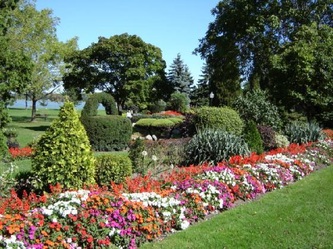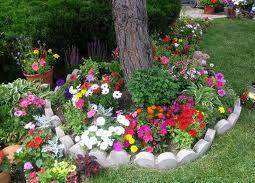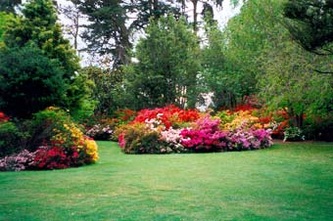Planting Annual Flowers
Annual plants complete their life cycle in one year. Although annuals last only one year their color display makes them worth the investment in your landscape. Some plants that are perennial in their native lands are treated as if they were annuals in regions too cold for them to complete their life cycle.
Annual flower gardens are easy and fun to grow. Color worshippers discover that entire beds of annuals best express their concept of what a garden should be.
On the other hand, some gardeners discover they prefer annuals as subtle accents, tucking single plants or small groupings into the perennial/shrub garden to add a dash of color or texture.
WHAT --- WHEN --- WHERE
HOW TO PLANT A GARDEN
WHERE:
Sun or shade or part-sun or part shade are the first and most obvious question a gardener asks when making their selections. The sun exposure of your garden needs to match the type of plant you chose and it's needs and tolerances. Some plants prefer full shade but will tolerate some sun, where others prefer full sun and will tolerate some shade. So, decide where you want to plant, and determine what type of sun exposure it has, then choose your plants based on what that exposure is for most of the day.
WHEN:
Soil temperature is a factor in determining when to plant in spring. Many annuals need warm soil to promote growing and settling. Some may grow too slowly if planted too soon in cool soil. Plant out after last killing frost. In our area, that can be anytime between April 15 thru May 31. Watching the current temperature and weather conditions will best aid you in making that decision.
WHAT:
Some annuals are more "hardy" and can stand cooler temperatures. The gamble or risk of a loss is much less with these choices, and an early planting should be fine. Some of these plants are Pansies, Dianthus, Osteospermum, and Petunia. Others, such as Begonias, Impatiens, Marigold, Geraniums, prefer warmer temperatures, and run a high risk of a loss due to a light frost. Patience, patience if you plan to add these to your garden.
Color, size and shape of the flowers, and foliage are also very important considerations. Cooler colors such as purple, blue and green, can make a small garden appear larger. The warm colors, red, orange and yellow, appear to fill up larger spaces. Colorful foliage can be used on their own or mixed in to provide an interesting contrast to brightly colored flowers.
HOW: (Care and maintenance tips)
Harden-off your plants you get from a greenhouse. This is the only home they have had up until now, and easing the transition to a garden is very beneficial. To do this, just set the plants outside (in their original containers) in an area that is guarded from wind on a nice day. Start with just a few hours per day and increase the time each day and until you can see that they have increased in strength. This process should be complete in 3-5 days. Then plant in your prepared garden site.
Soil preparation is very important. Well drained soil that has been loosened up with soil amendments such as peat moss or compost. Fluffy, soft soil conditions are the best. This is a good time to mix in fertilizer, whether it be a commercial or natural type.
Cover plants if a frost is expected to protect your plants from a loss. A light sheet is good, anything too heavy may break the plants because of its weight.
Moisture. Given enough moisture your annual garden will flourish! With adequate rainfall (in our area 20"-30" per year) annuals could handle 90 degrees Fahrenheit or a sudden cool snap. If we are lucky enough to get this rainfall in equal amounts each week throughout the growing season, there would be no need to water your garden. Even with an optimal amount of an inch of water per week you will still need to provide some supplemental moisture. Watering your garden in the mornings, or early evenings is the most efficient time.
Feed your plants. Regular applications of a water soluble fertilizer is needed by your plants. Choose a balanced blend and follow the instructions on the label.
HOW TO PLANT A GARDEN
WHERE:
Sun or shade or part-sun or part shade are the first and most obvious question a gardener asks when making their selections. The sun exposure of your garden needs to match the type of plant you chose and it's needs and tolerances. Some plants prefer full shade but will tolerate some sun, where others prefer full sun and will tolerate some shade. So, decide where you want to plant, and determine what type of sun exposure it has, then choose your plants based on what that exposure is for most of the day.
WHEN:
Soil temperature is a factor in determining when to plant in spring. Many annuals need warm soil to promote growing and settling. Some may grow too slowly if planted too soon in cool soil. Plant out after last killing frost. In our area, that can be anytime between April 15 thru May 31. Watching the current temperature and weather conditions will best aid you in making that decision.
WHAT:
Some annuals are more "hardy" and can stand cooler temperatures. The gamble or risk of a loss is much less with these choices, and an early planting should be fine. Some of these plants are Pansies, Dianthus, Osteospermum, and Petunia. Others, such as Begonias, Impatiens, Marigold, Geraniums, prefer warmer temperatures, and run a high risk of a loss due to a light frost. Patience, patience if you plan to add these to your garden.
Color, size and shape of the flowers, and foliage are also very important considerations. Cooler colors such as purple, blue and green, can make a small garden appear larger. The warm colors, red, orange and yellow, appear to fill up larger spaces. Colorful foliage can be used on their own or mixed in to provide an interesting contrast to brightly colored flowers.
HOW: (Care and maintenance tips)
Harden-off your plants you get from a greenhouse. This is the only home they have had up until now, and easing the transition to a garden is very beneficial. To do this, just set the plants outside (in their original containers) in an area that is guarded from wind on a nice day. Start with just a few hours per day and increase the time each day and until you can see that they have increased in strength. This process should be complete in 3-5 days. Then plant in your prepared garden site.
Soil preparation is very important. Well drained soil that has been loosened up with soil amendments such as peat moss or compost. Fluffy, soft soil conditions are the best. This is a good time to mix in fertilizer, whether it be a commercial or natural type.
Cover plants if a frost is expected to protect your plants from a loss. A light sheet is good, anything too heavy may break the plants because of its weight.
Moisture. Given enough moisture your annual garden will flourish! With adequate rainfall (in our area 20"-30" per year) annuals could handle 90 degrees Fahrenheit or a sudden cool snap. If we are lucky enough to get this rainfall in equal amounts each week throughout the growing season, there would be no need to water your garden. Even with an optimal amount of an inch of water per week you will still need to provide some supplemental moisture. Watering your garden in the mornings, or early evenings is the most efficient time.
Feed your plants. Regular applications of a water soluble fertilizer is needed by your plants. Choose a balanced blend and follow the instructions on the label.












